
Southern Africa
In its financial results for the six months ended 31 August 2005, Altech reported that all income, balance sheet and cash flow metrics showed strong positive increases. Revenue increased by 11% to R2,93 bn, with operating income of R250m. Altech said its balance sheet remains strong, with cash of R564m. Commenting on the interim results, Altech CEO Craig Venter said that the continued expansion of the company outside of South Africa, a focus on internal cost, project and process controls, a strengthening of its strategic customer relationships, and the roll-out of new products, all contributed to the company's pleasing performance. He commented that each of Altech's operations across the board performed ahead of their profit expectations, other than Namitech, which was affected negatively by a third party supply problem. Electronics components distributor, Altech Arrow Distribution, also reported positive results for the period.
An innovative project that allows commuters to use cashless rechargeable mobile cellphone cards to make calls from inside minibus taxis has proved to be phenomenally successful, says the Industrial Development Corporation (IDC). Partly funded with a R5m IDC loan, the Taxifone project is a partnership between the IDC, Taxifone, taxi association Top Six Management, and IT company Prism Holdings. The Taxifone concept - called SHESHA - uses a rechargeable pre-payment card that is inserted into a GSM payphone unit installed in a minibus taxi.
Comtest has appointed Brittan Healthcare as a value-added reseller for the Fluke range of industrial and electrical test products. For many years, Brittan Healthcare has been the sole southern African agent for Fluke's Biomedical range of test and simulation products, while at the beginning of this year, Comtest was appointed as sole distributor for Fluke's industrial and electrical test tools in southern Africa. Brittan Healthcare is a medical device manufacturer both in the electro-medical and consumable markets and supplies and services equipment for both the private and provincial sectors of the healthcare industry.
Afrac Enclosures and iS Electronics have moved to 4 Ivanseth Road, Reuven, Johannesburg. Tel: +27 (0)11 434 3302/3; Fax: +27 (0)11 434 2950.
Actum Electronics has moved to 5 Wessels Road, Rivonia. Telephone and fax numbers remain the same; Tel: +27 (0)11 803 7435/6; Fax: +27 (0)11 803 7049.
Overseas
Companies
IDT (Integrated Device Technology) has announced it has exercised an option to purchase the Freescale Semiconductor timing solutions business for $35m. This transaction was initiated by Integrated Circuit Systems (ICS) prior to the close of its merger with IDT. The acquisition will allow IDT to expand its broad portfolio of silicon-based communications timing solutions and enhance its expertise in this area.
Smiths Group is expanding its interconnect business with the acquisition of Millitech for $33,5 m, a company that specialises in the design and manufacturing of millimetre-wave components, assemblies and integrated antenna systems for satellite communications, radar, passive imaging, space and remote sensing applications.
Assa Abloy's Identification Technology Group (ITG) has acquired Tag Technology, an Italian distributor of advanced auto ID components to the RFID systems and smartcard solutions industry.
Applied Wave Research has acquired Aplac Solutions, which develops and markets simulation and analysis software for analog and radio-frequency design. Aplac's RF design technology has been used by Nokia, and has been used in designing over 30% of all mobile phone RF integrated circuits worldwide, according to the companies. The Aplac RF design tool has already been integrated into AWR's Microwave Office design suite. Aplac will be a wholly-owned subsidiary of AWR and will be called AWR-Aplac.
Epson Toyocom, formed through the integration of the quartz device business of Seiko Epson (Epson) and Toyo Communication Equipment (Toyocom), have started operations, aiming to be the largest global supplier of quartz crystals and oscillators. Epson Toyocom will have three categories of quartz-based devices: timing, sensing and optical devices. The company intends to differentiate its quartz business by offering a wide range of products in each category and also by offering integrated solutions spanning the three categories.
Infineon Technologies and Koncern Nauchny Centr, one of Russia's largest union of high-tech companies, have agreed to co-operate in the field of chip packages specifically used in smartcard applications. Based on the agreement, the companies will primarily promote wirebond packaging technology in Russia and the Commonwealth of Independent States (CIS). Infineon will make available its expertise in production methods for smartcard chip packages and will transfer two conventional assembly lines to KNC's semiconductor production facility.
Rheinmetall Defence Electronics has awarded RF Engines a contract for FPGA signal processing designs for an advanced flexible communication channelliser and a 52 MHz realtime spectrum analyser.
Skyworks Solutions has announced that it has signed an exclusive agreement with Motorola to jointly develop terrestrial trunked radio (TETRA)-based power amplifiers. The custom solution will be leveraged in Motorola's two-way radio platforms designed to meet the stringent requirements of public safety, government and enterprise customers worldwide.
Supercomputer firm, Cray, has announced that it is working with Sweden-based Mitrionics to provide users of the Cray XD1 supercomputer a faster way to implement application-accelerating FPGA technology. The Mitrion Virtual Processor and the Software Development Kit from Mitrionics enables supercomputer users to program FPGAs integrated in the XD1 system on a true software level, reducing the time and effort to take advantage of FPGA-based computation, say the companies.
ARM Holdings has teamed up with Ignios, a start-up that offers semiconductor IP and system development tools aimed at multiprocessor systems. Ignios has licensed ARM's RealView development tools, allowing its SystemWeaver tool to address multiple ARM9 processors and third-party DSP processors operating together.
Celestial Semiconductor, a Chinese company focusing on developing ICs to implement the Chinese AVS (audio video standard) multimedia standard, has licensed LSI Logic's ZSP400 DSP core and ZSP Audio Platform.
Rambus has signed a renewed patent license agreement with Japan's Renesas Technology that allows the development and manufacture of ICs employing Rambus' interfaces. The agreement is for a five-year term.
Alcatel has been awarded a 120m Euro contract to build and deploy a converged high-speed telecommunication network alongside England's motorways. The project is managed by GeneSYS, the consortium selected to deploy the National Roads Telecommunications Services (NRTS) on behalf of the UK Highways Agency. The UK Highways Agency currently manages and maintains 28 networks with data coming from over 11 000 roadside devices. Alcatel says the installation of a single, IP-based optical backbone network will improve the transmission of various types of information such as CCTV footage, variable messaging and electronic signalling, as well as enhance the delivery of commercial services such as emergency telephony.
Konarka Technologies, a company specialising in plastics with optoelectronics properties, has formed a joint development program with Textronics, a developer of electronic textiles. The two intend to create prototype garments and fashion accessories with portable, wearable power-generation capabilities. The items would use Konarka's light-activated 'Power Plastic' to provide renewable, wearable energy sources for personal electronic devices, said Konarka.
Industry
The three-month average of worldwide semiconductor sales in August came in higher than expected at $18,58 bn, up 3,2% from $18,01 bn in July. This was also up 1,7% from the equivalent August 2004 figure, according to the World Semiconductor Trade Statistics (WSTS) organisation in figures published by the European Semiconductor Industry Association (ESIA). On a year-to-date basis, the August three-month average represents a 5,8% increase, the same as in July but down from the 6,4% recorded in June, ESIA said.
The wireless mesh network (WMN) infrastructure equipment market has begun to accelerate, reports In-Stat. From 2004 through 2009, the market for access points is expected to grow from $33,5m to $974,3m, it says. WMNs were developed as a quick way to set up wireless networks during military operations. The technology makes all radios in a network capable of two-way communication with other radios in the network. Further, In-Stat has found: Wi-Fi-based WMNs are being applied as Hot Zones, which cover a broad area such as a downtown city district; most WMN activity is in North America; WMN is a powerful and potentially, disruptive technology - it is already being used to extend the range of Wi-Fi technology, and has the potential to expand and extend the reach of numerous wireless technologies from WiMAX to ultrawideband.
Recent announcements from Alien Technology and Avery Dennison suggest that the prices of RFID tags are finally coming down. Alien has cut the price of its straps to 12,9 US cents, while Avery Dennison is offering inlays at 7,9 US cents, according to ABI Research. However, even a sub-8-cent price is still well above the 5-cent point that some industry analysts earlier touted as the price needed to ensure a viable RFID industry, says ABI. However, that number has more recently been viewed as too simplistic in any case. "These new low prices may represent loss-leaders," comments Erik Michielsen, a director at ABI. "But when you tie them to the new products and services offered by software companies to help end-users make sense of their RFID data, and to the recent spate of EPC Gen 2 announcements, we may have a three-headed 'benevolent monster' that will promote demand."
The IMS (IP multimedia subsystem) has become one of the hottest topics in telecoms, according to In-Stat. The research firm believes that IMS provides a unifying vision for the future of telecommunications. It is more appropriate now to think of IMS as an overall IP multimedia system that consists of a single, converged architecture for wireline and wireless service providers, end-user devices with the required IP multimedia functionality, and the systems integration necessary to deliver high-quality IP multimedia services between any set of wireline and wireless end-users. IMS is a revolutionary vision for the future of the telecoms industry, states In-Stat, leading to new multimedia services, new network architectures, new business models and relationships, and new end-user devices with new capabilities. In the long term, all telecommunications services (voice services, business networking services, the Internet, IPTV) will be provided through IMS, says the group.
Bluetooth is firmly established as a short-range wireless solution for voice and data transmission, as 2005 will be the fourth consecutive year in which Bluetooth-enabled product shipments more than double, reports In-Stat. This year's shipments are forecast to be 316 million units, a total that will rise to 866 million in 2009. However, Bluetooth will need to constantly adapt in the face of competition, which includes Wireless USB, Wireless 1394, and Wi-Fi.
In the first six months of 2005, another 24,5 million homes and businesses around the world moved to broadband, according to the latest data from Point Topic, produced for the DSL Forum. By end June 2005, there were 176 million broadband connections, with digital subscriber line (DSL) accounting for almost three-quarters of total broadband growth in the year. Almost 115 million now choose DSL for broadband access, according to the research group, with 17,7 million subscribers added in the first half of 2005 - more than two and a half times of other broadband technologies. With 47,5 million subscribers, the EU has taken over from North America as the world's number one broadband region. In 16 countries, at least one in 10 people have a broadband connection - half of these nations are in Europe. China has been fast-tracking its broadband development, and of the established DSL nations, the fastest growing are Australia at 40%, the UK at 37% and Brazil at 27%.
Sanyo Electric has announced it will accelerate its three-year revitalisation project by cutting 10 000 jobs by January 2006, two-thirds of the 15 000 job cuts originally planned to take place by fiscal 2007.
Power supply manufacturer, Power-One, has filed a lawsuit against rival power supplier Artesyn Technologies, for allegedly infringing several patents related to power converters. In its complaint, Power-One alleges that Artesyn is infringing patents relevant to its recently-announced DPL20C POL converter.
The IEEE has created a new Task Force, IEEE 802.3at, based on the objectives outlined by its PoEPlus Study Group. It will be responsible for creating an enhanced PoE standard, dubbed PoEPlus, which will provide increased power of at least 30 W to powered devices, such as VoIP phones, WLAN access points, and network security cameras. The existing 802.3af PoE standard, which was adopted by the IEEE in June 2003, enables powered devices to receive as much as 12,95 W of power.
Two UK-based engineering institutes are to merge. The IEE and IIE will combine, forming the IET (Institution of Engineering and Technology), to come into being in early 2006. The IEE has 120 000 members worldwide and the IIE 40 000. The institutes' original plan, to have a three-way merger with ImechE (Institution of Mechanical Engineers), was discarded in 2004.
The US has rejected calls for a UN body to take over control of the management of the Internet. At the last preparatory meeting in Geneva, ahead of November's UN World Summit on the Information Society in Tunisia, ambassador David Gross, US coordinator for international communications and information policy at the State Department stated: "We will not agree to the UN taking over the management of the Internet. Some countries want that. We think that is unacceptable." In 1998, the US Commerce Department selected ICANN to oversee the Internet's master directories.
The European Commission has agreed to fund a collaborative project to consider and coordinate research in photonics and nanotechnologies. As part of the Sixth-Framework Program, the EC has agreed to provide MONA (merging optics and nanotechnologies) with 950 000 Euros in funding.
Power.org, an open community developing standards and applications around IBM's Power Architecture, has announced that eight new members have joined the organisation, bringing its membership to more than 30.
The Bluetooth Special Interest Group (SIG) is updating its Qualification Program with new tools in a bid to help companies get Bluetooth products to market faster. The latest tools and revised program should ensure better interoperability, verify conformance to the Bluetooth specifications, and strengthen the SIG's ability to enforce compliance, it said.
Munich Trade Fairs International has launched the 'Global electronics Club' Internet portal. Intended as a 24/7 networking platform for the electronics sector, the trade-fair company says that www.ge-club.net is the first business network for the worldwide electronics industry. The Global electronics Club relies on the Social Software Technology from openBC, a leading European business networking platform, which currently has 650 000 members worldwide.
Ixys has reported it has received substantial orders for its integrated MOS and bipolar modules as a direct result of portable generator manufacturers responding to the immediate demand for alternate electric power sources in light of recent electricity blackouts. "We are moving very quickly to provide fast delivery of our products to OEM customers around the world in order to meet the demand for portable generators and other industrial equipment such as soft-start controllers and motor generator sets," said Dan Schwob, vice president of marketing at Ixys. "The unfortunate natural disasters of the last 20 months again highlight the importance of alternative sources of electricity as well as back-up sources of energy, like uninterruptible power supplies."
Technology
VK, a Korean cellphone manufacturer, has launched what is arguably the slimmest and lightest handset on the market today - the 8,8 mm thick VK2000, which weighs only 48 grams. The black, bar-type model is said to have a compact metal feel and is sized as long and wide as a business card at 49,9 x 89,9 mm. It is to be offered for sale in China and surprisingly, will be targeted at budget-sensitive customers at a price around $100.
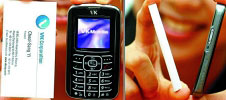
Radio amateurs worldwide are being asked to help collect data from the student-built SSETI Express satellite, due to be placed in orbit on 27 September. To encourage them, the European Space Agency's education department has organised two competitions and is supplying free downloadable software. Radio amateurs worldwide are being asked to help with the downlink of housekeeping and payload data. In return, the SSETI Express UHF and S-Band communications systems will be made freely available to the radio amateur community, along with the mission data downlink, once the main mission objectives of SSETI Express are complete.
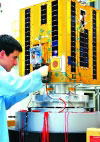
Flash memory card maker SanDisk has launched a music format dubbed 'gruvi' that could eventually replace CDs. The music cards are the size of a fingernail, and use the company's TrustedFlash secure format. They will come pre-recorded with music and are suitable for playback on mobile phones, PDAs and laptop computers. SanDisk says the cards will allow consumers to use them in a variety of supported devices, in contrast to today's closed, proprietary systems that bind content to a particular host device. The encryption technology embedded in the card allows it to be the digital rights manager, giving consumers the freedom to transfer the card - and its content - to other supported devices without compromising its content protection system.
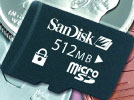
Software-defined-radio technology provider, TechnoConcepts, has filed 20 patent claims to protect its 'linear commuting amplifier' design, a key circuit implementation that enables integrating a commutator (to translate signals in frequency) with its high-performance delta-sigma ADC to form a direct RF-to-digital (RF/D) converter as already stated in TechnoConcepts' Delta-Sigma Receiver patent.
Qualcomm has announced that its Mobile Station Modem chipsets will support Philips' wireless local area network (WLAN) module. The integrated solution will offer connectivity to WLAN networks as well as to existing cellular networks and will feature compatibility with 802.11b and 802.11g protocols on both CDMA2000 and WCDMA (UMTS) networks. The WLAN solution will allow mobile handsets to use high-speed WLAN when available, for connections of up to 54 Mbps.
Focus Enhancements has developed an 880 Mbps ultrawideband chip. The analog/RF chip is the first of a two-chip set UWB device targeting wireless video distribution and high-speed data transfers, according to the company.
Wipro Technologies has demonstrated video transfer between two laptops using ultrawideband (UWB) technology. The demonstration at Wireless USB Devcon, in Tokyo, used Wipro's WiMedia MAC IP core and third-party PHY along with RF modules in accordance with the WiMedia Alliance's Common Radio Platform.
IRF Semiconductor has begun sampling a quad-band RF transceiver implemented in CMOS that is intended for use with GSM/GPRS/EDGE family of wireless communication standards. The company says its CMOS configurable radio frequency 'platform' design is applicable to cellular 2G, 2.5G and 3G handsets - as in the first chip sampling - and to GPS, wireless LAN and WiMax systems.
SanDisk and Sony have launched a jointly-developed removable flash storage Memory Stick card dubbed the Micro, and are targeting the recording format at the mobile phones sector. The card measures 15 x 12,5 mm and is only 1,2 mm thick - about one quarter the size of the current Memory Stick PRO Duo. The cards will transfer data at 160 Mbps.
Responding to service providers' growing interest in offering 'triple play' voice, data and video services, Texas Instruments unveiled at the Broadband World Forum a new residential gateway reference design that serves as a DSL modem, router and IPTV set-top box. The new reference design, dubbed AR7STB, combines TI's DSL router with its media processor built around its C64x DSP core. TI said its AR7STB will enable service operators to provide both broadcast video and data services through a DSL connection.
LG Chem, the largest chemical company in South Korea, has completed the development of what it claims is the world's most advanced portable fuel cell, which it plans to commercialise within this year. Methanol fuel will be used to power the cell, and according to LG Chem, it lasts for more than 4000 hours - around eight times longer than competitive products. The miniaturised product, which weighs less than 1 kg, is claimed to be able to power a 25 W laptop for more than 10 hours, with a single 200 cc fuel cell charge.
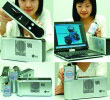
Researchers at Dartmouth College have created what they claim is the world's smallest untethered, controllable robot. Their extremely tiny machine measures 60 x 250 μm, integrates power delivery, locomotion, communication, and a controllable steering system - the combination of which they say has never been achieved before in a machine so small. The robot contains two independent micro-actuators, one for forward motion and one for turning. It is tele-operated, powered by the grid of electrodes it walks on and it moves by bending its body like a caterpillar. The charge in the electrodes not only provides power, it also supplies the robot's instructions that allow it to move freely over the electrodes, unattached to them.

Automotive component firm, Valeo has combined discharge lamps and LEDs in its Xenon Dynamic Bending Light headlamps. Demonstrated at the recent Frankfurt motor show, the discharge lamps provide forward illumination while the LEDs selectively broaden the beam. Multi-emitter prototype LED headlamps are currently being used to produce 'steerable' beams, whose shape and intensity is varied with vehicle speed and steering wheel position.
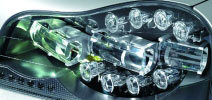

© Technews Publishing (Pty) Ltd | All Rights Reserved